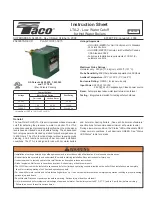
© MHG Heating Ltd
59
MHG Heating Ltd Unit 4 Epsom Dow ns Metro Centre, Waterfield, Tadw orth, Surrey KT20 5LR
Telephone 01737 358000 Fax 08456 448803 Email
Web w w w .mhgheating.co.uk
010717
12.0 Routine Inspection and Servicing
Maintenance should be carried out in the appliance on at least an annual basis dependent on usage. during the
servicing of the appliance any faults should be identified and remedied immediately to avoid further damage to the
system.
The boiler should be inspected only by a qualified service engineer. in addition, the maintenance and care of the
boiler designated and explained on the following pages must be performed to ensure maximum boiler efficiency and
reliability.
Failure to service and maintain the boiler as detailed could lead to equipment premature failure.
12.1 Maintenance Procedure
During maintenance the following points should be checked and/or part must be inspected and maintained.
Before undertaking any work on the appliance notes and comments from the customer should be taken and
investigated if any faults are reported.
Servicing of heat exchanger
1: Ensure electrical supply to boiler is isolated and made safe. Ensure that gas supply to boiler is isolated.
2: Allow time for the boiler to cool to a safe temperature to handle if it has been firing.
3: Remove the case from the boiler to allow access to the internal components.
4: Disconnect the internal gas pipe from the inlet pipe.
5: Disconnect the earth lead, HT cap and Lead from the ignition electrodes. Also removing rectification lead from
probe
6: Disassemble the burner by removing the nuts around the burner door. Pull the burner forward and remove from
the heat exchanger. Gently put to one side.
7: Once access has been gained to the combustion chamber and front section
of the heat exchanger, inspect heat exchanger for any signs of
overheating. Using a NATURAL BRISTLED brush only, remove the
debris built up on the heat exchanger.
8: Remove the heat exchanger side inspection panels.
Release the retaining nuts from heat exchanger cover plate,
remove plate, be careful not to damage the gasket, store safely.
Heat exchanger can be washed with clean water, if badly
contaminated, cl
ean with a small stiff bristle “bottle type” brush or
use the special cleaning tool (supplied optional). Care should be
taken when using water in the confined space of the boiler casing
to avoid contaminating the electrical controls.
9: Remove and clean out condensate syphon. Inspect condensate drain for any signs
of leaks. Remove condensate collector inspection door. Flush through any debris.
If satisfied reassemble condensate syphon to boiler.
10: Inspect burner and burner door seals. If any signs of damage replace item.
11: Inspect ignition electrode and rectification probes. Replace on an annual basis or as required. Ensure gaskets
are replaced along with probes to ensure a tight seal against burner door.
12: Inspect the fan and venturi assembly for any signs of damage or build-up of debris. Use compressed air or a
brush to clean the venturi. Ensure the silicone tube between venturi and gas valve is clear and in good
condition. If the fan blades have a build-up of debris a brush can be used to clean each blade in turn. Care
must be taken to ensure the balance of the fan is not altered by the use of too much force.
13: Reinstall the burner, and burner door to heat exchanger ensuring all seals are intact.
14: Once the boiler is re assembled a gas tightness test must be carried out.
15: A Flue gas analysis must be completed on the completion of the tightness test.








































